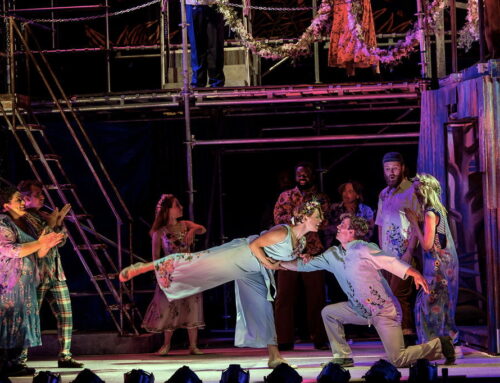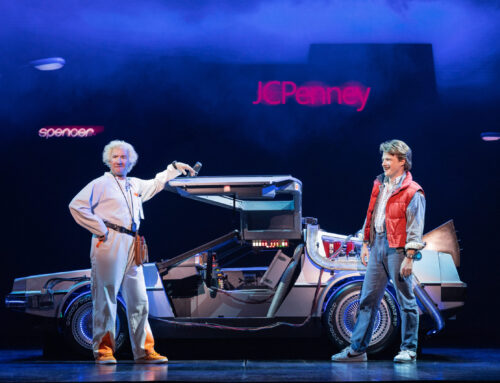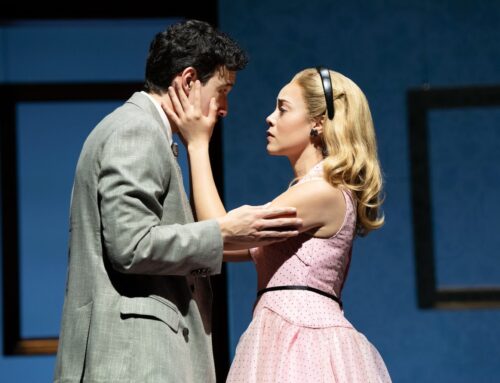Two musicals have just descended on the Boston area: one old, one new–each with its ups and downs.
First,”Come and meet those dancing feet/On the avenue I’m taking you to/42ND STREET“–now in Waltham at the REAGLE THEATRE just finishing up its 49th season! This is the final weekend of a very short run of “42nd Street” and this production beats its heart out and ultimately won mine. The tunes:”We’re in the Money,” “You’re getting To Be A Habit With Me,” “Lullaby of Broadway” and the eponymous “42nd Street” as well as Gower Champion’s original toe-tapping choreography (snappily recreated) carry the day. Also delightful are the uber-exuberant Mara Cecilia as little Peggy Sawyer who goes on at the last minute to replace a daunting diva of a star, Dorothy Brock (a beautiful, full-throated Rachel York) and becomes a star herself!
The actual behind-the-scenes story is a real-life twist on the show’s set up. This production’s original star Tom Wopat who was to play producing honcho Julian Marsh was sacked at the last minute for reportedly “misbehavin’ ” and his understudy Rich Allegretto had to go on for him at the 11th hour, but his performance did not go to “11.” This caused a negative ripple effect in the casting. The show also carries big “schtick” and needed a lighter directorial touch with some of the minor characters. But James Darrah as leading lothario Billy Lawlor and Beth Martin Pierce as the wisecracking mother hen “Maggie Jones” have the right idea. And by the end of the night, Ms. Cecilia’s superb vocal and acting chops, not to mention her cataclysmic tapping, stole my heart in the climactic number and brought the house down. I was positively jubilant, along with Peggy Sawyer’s cast mates who were thrilled to see one of their own, a little nobody from nowhere, become a somebody over night–with nary a jealous crack in the ranks. How quaint– and refreshing. See it at the REAGLE THEATRE in Waltham through this Sunday August 13!
 Then there’s FINDING NEVERLAND which just opened at The Boston Opera House, and while entertaining, it has yet to find the magic dramatically. Since Diane Paulus directed its premiere at the American Repertory Theater in Cambridge and ushered it to Broadway last season, the show’s production values have been enhanced and its story streamlined and sharpened.The musical is based on the 2004 film and the play by Allan Knee called THE MAN WHO WAS PETER PAN about Scottish novelist/playwright J.M.Barrie who meets a widow and her four little boys. They inspire the playwright to create his most famous work, escape a claustrophobic marriage, and heal a family tragedy from his past.
Then there’s FINDING NEVERLAND which just opened at The Boston Opera House, and while entertaining, it has yet to find the magic dramatically. Since Diane Paulus directed its premiere at the American Repertory Theater in Cambridge and ushered it to Broadway last season, the show’s production values have been enhanced and its story streamlined and sharpened.The musical is based on the 2004 film and the play by Allan Knee called THE MAN WHO WAS PETER PAN about Scottish novelist/playwright J.M.Barrie who meets a widow and her four little boys. They inspire the playwright to create his most famous work, escape a claustrophobic marriage, and heal a family tragedy from his past.
There are now gorgeous projections to fill out many of the scenes and heighten the atmosphere. The tale feels more focused and they’ve drawn a clearer line between Barrie’s imagination which is stifled and the little boys who’ve just lost their father. The adult cast is marvelous; Billy Harrigan Tighe as J.M. Barrie is appealing with a clear cool voice that does the trick. Christine Dwyer as widowed mom Sylvia Llewelyn Davies uses her gorgeous vocals in the most affecting way. Karen Murphy brings her powerful vocals to bear on Mrs. du Maurier who is simultaneously stern and warm. As the blustery theater producer John Frohman–and almost stealing the show — is an astonishingly charismatic John Davidson. Yes. That John Davidson who I grew up watching on TV variety shows in the 60’s, and 70’s. The performer remains downright dashing and a perfect ham when called for, and it is called for here.
But the show doesn’t build a convincing, moving relationship between the boys who spark Barrie’s imagination and Barrie. “Peter” seems especially opaque here; I found it hard to understand exactly what the young actor playing him was saying onstage. Nor is Barrie’s writer’s block made to seem all that urgent a dilemma, so when the big production number involving Captain Hook sets sail (along with Barrie’s imagination) before our very eyes, the scene still feels unearned– too much “sturm” and not enough “drang.” Act II drags and the show’s last scene feels anticlimactic and tacked on.
What remains are beautifully staged moments/scenes in search of a dramatic arc that would engage us emotionally. Some of these scenes in themselves are magic: that romantic duet between Barrie and Sylvia on a darkened stage by “ghost” light; and the star-dappled, translucent climax, despite some overly muscular dancing by the acting troupe, is enchanting. Here the players within the play bring the world of “make-believe” and the real world together, and it still casts a spell. But the show’s big themes– life and death, love and loss, reality and imagination– remain untethered dramatically for most of the show, making it hard to find all the magic imaginable in FINDING NEVERLAND. At the Boston Opera House through August 20th.







Leave A Comment
You must be logged in to post a comment.